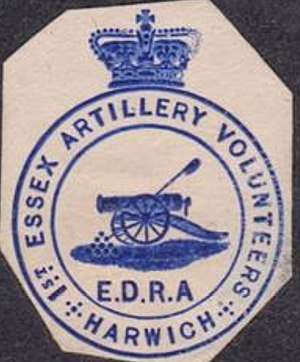1st Essex Artillery Volunteers
The 1st Essex Artillery Volunteers were formed in 1860 as a response to a French invasion threat. They became part of the Territorial Force in 1908 and served during the First and Second World Wars until amalgamated in 1956.
| 1st Essex Artillery Volunteers 2nd East Anglian Brigade Royal Field Artillery (TF) 85th (East Anglian) Field Regiment RA (TA) | |
|---|---|
 Crest of the 1st Essex Artillery Volunteers, c1890 | |
| Active | 1860–1956 |
| Country | |
| Branch | |
| Type | Artillery Regiment |
| Role | Garrison Artillery Field Artillery Airborne Artillery |
| Garrison/HQ | Stratford Green, London |
Artillery Volunteers 1861–1908

The first Corps in Essex was formed at Harwich on 18 February 1860.[1] A second Corps was raised at Barking in September 1860. The third Corps was raised at Plaistow on 26 June 1861, and from 1864 until 1867 was attached to the 10th Kent Artillery Volunteers.
When volunteers were reorganised in 1880, the old Corps were re-designated batteries, with headquarters at Stratford. The batteries were distributed as follows:
- 1st Battery – Barking, Essex
- 2nd Battery – Grays, Essex (former 2nd Corps)
- 3–10 Batteries – Stratford (former 3rd Corps)
In 1899, the two batteries located at Harwich were moved to create a new Corps, designated as the 1st Suffolk and Harwich Artillery Volunteers.
Territorial Force 1908–1920
In 1908, on the formation of the Territorial Force, the 1st Essex became the 2nd East Anglian Brigade Royal Field Artillery (TF). This brigade comprised the 1st, 2nd and 3rd Batteries. Five batteries were combined with the 1st Suffolk and Harwich Artillery Volunteers to form the Essex and Suffolk Royal Garrison Artillery (TF).[2]
The Brigade headquarters were at Artillery House, The Green, Stratford.[3] The 3rd Battery had a drill hall on the High Street, Grays, Essex.[4]
During the First World War, the Brigade served in the UK and France. In 1916, the Brigade was renumbered as 271st Brigade Royal Field Artillery (TF). They were placed in suspended animation in 1919.[5]
Interwar years
After the war, the unit was reconstituted, with four batteries, as the 2nd East Anglian Brigade RFA (TF) in the reformed Territorial Army.. In 1921, it was reorganised again, this time as the 85th (East Anglian) Brigade RFA (TA), at which time the batteries were numbered 337 to 340.[6] In 1925, 339 battery was redesignated as the 339th (Essex RHA) Battery.
Second World War
By the outbreak of the Second World War, the unit had been redesignated as 85th (East Anglian) Field Regiment RA (TA). In 1943, it was reorganised and redesignated as 85th Mountain Regiment RA (East Anglian)(TA). At the end of the war, the unit was placed in suspended animation in 1945.[7]
Postwar
In 1947, the unit was reconstituted as 285th Airborne Light Regiment RA (Essex) (TA).[8]
In 1951, the Regiment was reorganised as 285th Airborne Field Regiment RA (Essex)(TA). In 1956, the Regiment was amalgamated with 292nd (5th London) Airborne Field Regiment RA (TA) to form 289 Parachute Light Regiment, Royal Artillery (TA).
Notes
- Litchfield, Norman E H, and Westlake, R, 1982. The Volunteer Artillery 1859–1908, The Sherwood Press, Nottingham, p67
- London Gazette, 20 March 1908.
- Osborne, Mike, 2006. Always Ready: The Drill Halls of Britain's Volunteer Forces, Partizan Press, Essex, p232
- Osborne, Mike, 2006. Always Ready: The Drill Halls of Britain's Volunteer Forces, Partizan Press, Essex, p159
- Litchfield, Norman E H, 1992. The Territorial Artillery 1908–1988, The Sherwood Press, Nottingham, p63.
- Litchfield, Norman E H, 1992. The Territorial Artillery 1908–1988, The Sherwood Press, Nottingham, p64
- Litchfield, Norman E H, 1992. The Territorial Artillery 1908–1988, The Sherwood Press, Nottingham, p64
- Litchfield, Norman E H, 1992. The Territorial Artillery 1908–1988, The Sherwood Press, Nottingham, p64
References
- Ian F.W. Beckett, Riflemen Form: A Study of the Rifle Volunteer Movement 1859–1908, Aldershot, The Ogilby Trusts, 1982, ISBN 0-85936-271-X.
- Lt-Col H.F. Joslen, Orders of Battle, United Kingdom and Colonial Formations and Units in the Second World War, 1939–1945, London: HM Stationery Office, 1960/Uckfield: Naval & Military, 2003, ISBN 1-84342-474-6.
- Litchfield, Norman E H, and Westlake, R, 1982. The Volunteer Artillery 1859–1908, The Sherwood Press, Nottingham. ISBN 0-9508205-0-4
- Litchfield, Norman E H, 1992. The Territorial Artillery 1908–1988, The Sherwood Press, Nottingham. ISBN 0-9508205-2-0
- Osborne, Mike, 2006. Always Ready: The Drill Halls of Britain's Volunteer Forces, Partizan Press, Essex. ISBN 1-85818-509-2